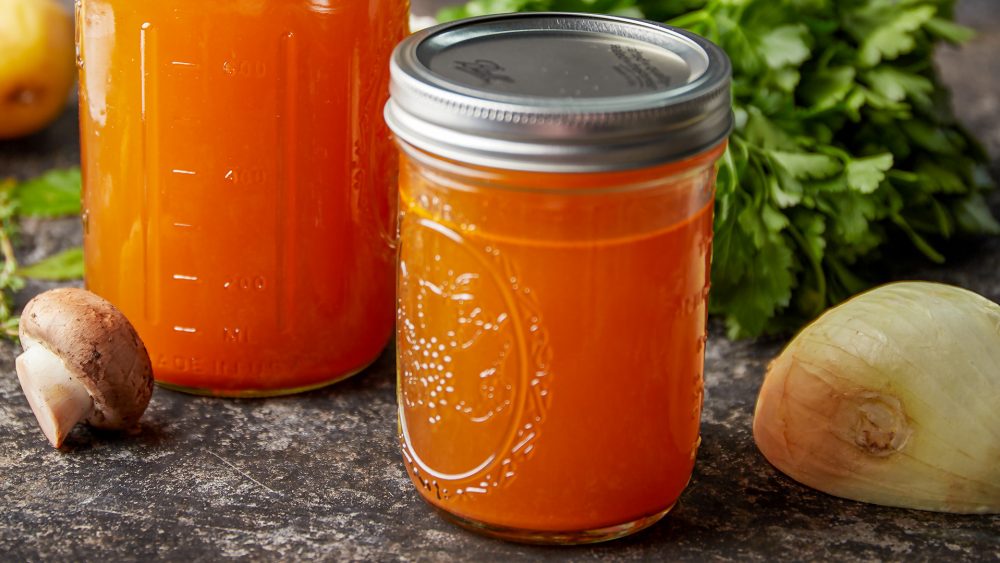A few things make our Homemade Vegetable Broth better than the rest. The addition of cremini mushrooms, tomato paste, and potatoes solve the problem of watery blandness. The first two add deep, savory flavor, the third gives the broth a silky, round texture often lacking in meat-free broths. Onion, carrot, and celery round things out with the classic, versatile flavors you expect from vegetable broth.
We also keep the pot tall and slender, which helps the broth simmer without over-reducing, and we aren’t bashful with the bay leaves. All of this translates into a wildly better, satisfying vegetable broth that puts the box of store-bought stuff to shame.
Up the umami with mushrooms and tomato paste
Glutamates, or glutamic acids, are the building blocks of umami. Without them, some of our favorite foods would be rendered bland and boring. Parmesan cheese would fall flat, soy sauce would be so-so, and meat would be pretty gross (the flavor of pure protein is not fun). But glutamates work best with a partner. Pairing glutamates with nucleotides creates something called umami synergy: While nucleotides don’t add much flavor on their own, they directly affect the way glutamates bind to the tastes receptors in your mouth, allowing them to bind more effectively, amplifying the umami flavor fifteen-fold.
You can read all about the science of umami here, but all you really need to know is that umami synergy plays a big role in this broth. Both mushrooms and tomatoes contain their fair share of glutamates, but mushrooms also provide a dose of flavor-amplifying nucleotides, giving this broth a wallop of deep savoriness.
But we don’t just chuck mushrooms and tomato paste into the pot and let them boil away, we brown them, which sets off a series of chemical reactions that creates hundreds of new flavor compounds. It also drives off water from the mushrooms, concentrating them down, and caramelizes the sugars in the tomato paste while tempering the acidity. Deglazing the pot and scraping up the little browned bits before adding the other ingredients ensures not even a speck of flavor is left behind.
Add potatoes for body
Like all good vegetable stock, this one is flavored with a trio of onion, carrots, and celery, but the addition of the humble potato is what makes it great. Much like pasta cooking water, the water in which you boil potatoes contains a substantial amount of starch. If you’ve made our Milk-Simmered Mashed Potatoes, you know why we think of this starch as “liquid gold.”
Potato starch (and pasta water) contains amylopectin, a tangly, bushy molecule that gets caught on itself, slowing down the flow of the liquid and upping the viscosity. Partially broken down potatoes give the vegetable broth a silky, substantial texture, without the need for any collagen-heavy bones or added dairy. Potatoes also give the broth an anchoring, earthy flavor and subtle sweetness, something that store-bought brands are often lacking.
Keep the pot tall and slender
You don’t need any special equipment to make a pot of broth, but pot shape can influence how quickly your stock reduces. A narrowish stockpot with about an 8-quart capacity is ideal, as liquid will not evaporate as quickly as it would in a Dutch oven. If a Dutch oven is the only option, partially cover the pot during simmering to prevent over-reduction. You can also add more water as needed, but we prefer to keep our stock as hands-off as possible.
Don’t be bashful with the bay leaves
I’ve often said that bay leaves are the dryer sheets of the kitchen—most people can’t explain what they do, but they throw them in there anyway. But bay leaves add a delightful tea-like, almost menthol-y roundness. The only problem? Most people don’t add enough. One bay leaf per recipe seems to be the going rate, but the leaves lose potency as they sit, so there’s no reason to ration them out this way. Our vegetable broth calls for not one, not two, not even three bay leaves, but four.
If you’re worried the extra leaves will give your broth an overwhelming medicinal note, don’t be. The broth simply tastes like a better, slightly more pungent and savory version of itself, with a complexity you’d never get from a box. It’s round, deep, and packed with vegetable flavor—anything but watery and bland.
Join the conversation on Facebook, Instagram, TikTok and Pinterest.
And if you're looking for more Milk Street, check out our livestream cooking classes with our favorite chefs, home cooks and friends for global recipes, cooking methods and more.







